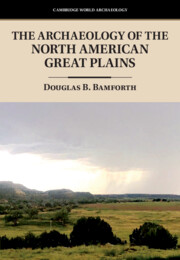Book contents
- The Archaeology of the North American Great Plains
- Cambridge World Archaeology
- The Archaeology of the North American Great Plains
- Copyright page
- Dedication
- Contents
- Figures
- Tables
- Acknowledgments
- Chapter 1 Introduction
- Chapter 2 Where and What Are the Great Plains?
- Chapter 3 Peopling the Continent, Peopling the Plains:
- Chapter 4 Paleoindian Hunters (and Gatherers):
- Chapter 5 Diversity, Environmental Change, and External Connection:
- Chapter 6 Mounds, Pots, Pipes, and Bison:
- Chapter 7 The Context of Maize Farming on the Great Plains
- Chapter 8 Settled Farmers and Their Neighbors, Part 1:
- Chapter 9 Settled Farmers and Their Neighbors Continued:
- Chapter 10 The Plains Village Period, Part 3:
- Chapter 11 One Promise Kept:
- Chapter 12 Afterword
- References
- Index
Chapter 12 - Afterword
Published online by Cambridge University Press: 19 November 2021
- The Archaeology of the North American Great Plains
- Cambridge World Archaeology
- The Archaeology of the North American Great Plains
- Copyright page
- Dedication
- Contents
- Figures
- Tables
- Acknowledgments
- Chapter 1 Introduction
- Chapter 2 Where and What Are the Great Plains?
- Chapter 3 Peopling the Continent, Peopling the Plains:
- Chapter 4 Paleoindian Hunters (and Gatherers):
- Chapter 5 Diversity, Environmental Change, and External Connection:
- Chapter 6 Mounds, Pots, Pipes, and Bison:
- Chapter 7 The Context of Maize Farming on the Great Plains
- Chapter 8 Settled Farmers and Their Neighbors, Part 1:
- Chapter 9 Settled Farmers and Their Neighbors Continued:
- Chapter 10 The Plains Village Period, Part 3:
- Chapter 11 One Promise Kept:
- Chapter 12 Afterword
- References
- Index
Summary
I began this volume by noting the disconnect between widespread and long-standing views of the indigenous people and environment of the Great Plains and the reality of the character and history of that region. Mounted bison hunters like the ones we often visualize did live on the grasslands, but they existed for little more than a century and a half and many of the most famous groups who lived this way migrated to the Plains during the Colonial Era. Focusing on them neglects not only the farmers who dominated the Plains for a millennium but also the diversity of hunter-gatherer ways of life that people have lived there for perhaps 15,000 years or more. Like human history throughout North America, human history on the Plains is not a story of an unchanging way of life fixed for centuries in the forms that Euroamericans encountered; it is a story of constant change and interaction between human beings and the region’s potentials and limits. It is also a story that is difficult to understand without thinking about how Plains people reached out beyond the grasslands, establishing social and economic connections that spanned much of North America.
- Type
- Chapter
- Information
- The Archaeology of the North American Great Plains , pp. 386 - 392Publisher: Cambridge University PressPrint publication year: 2021

